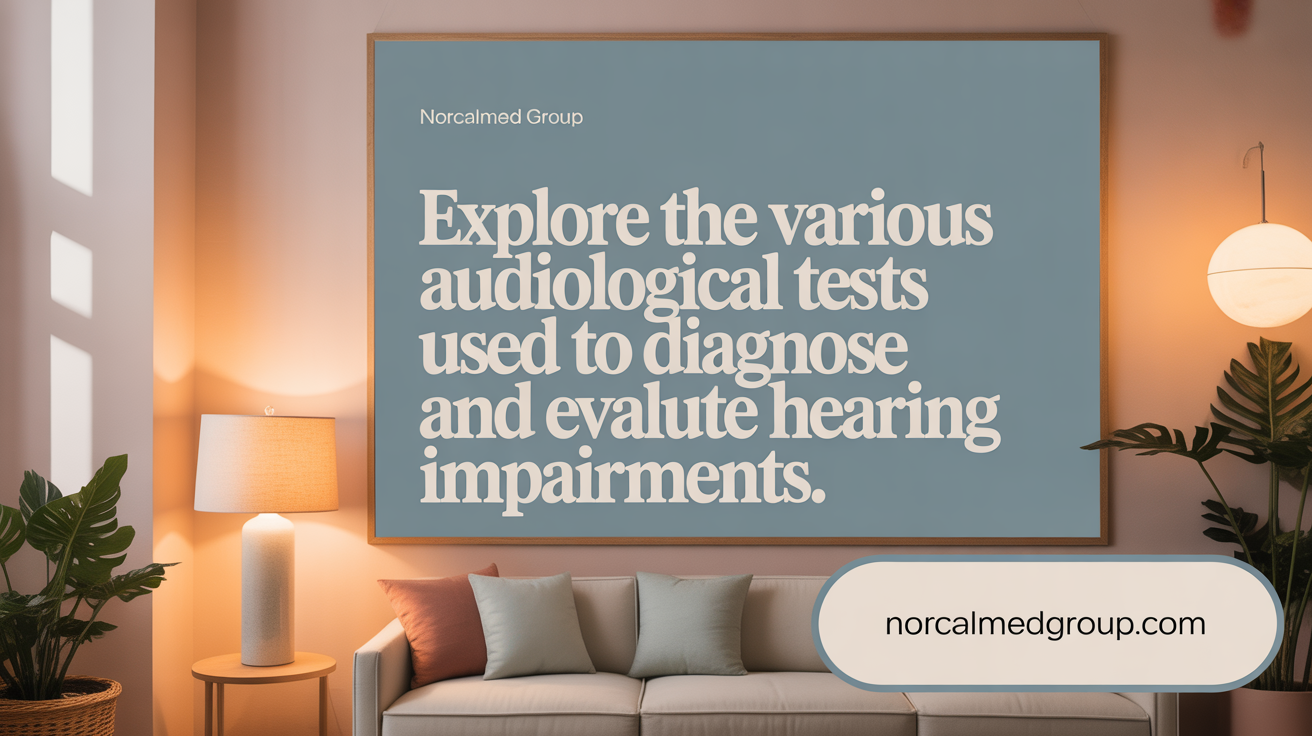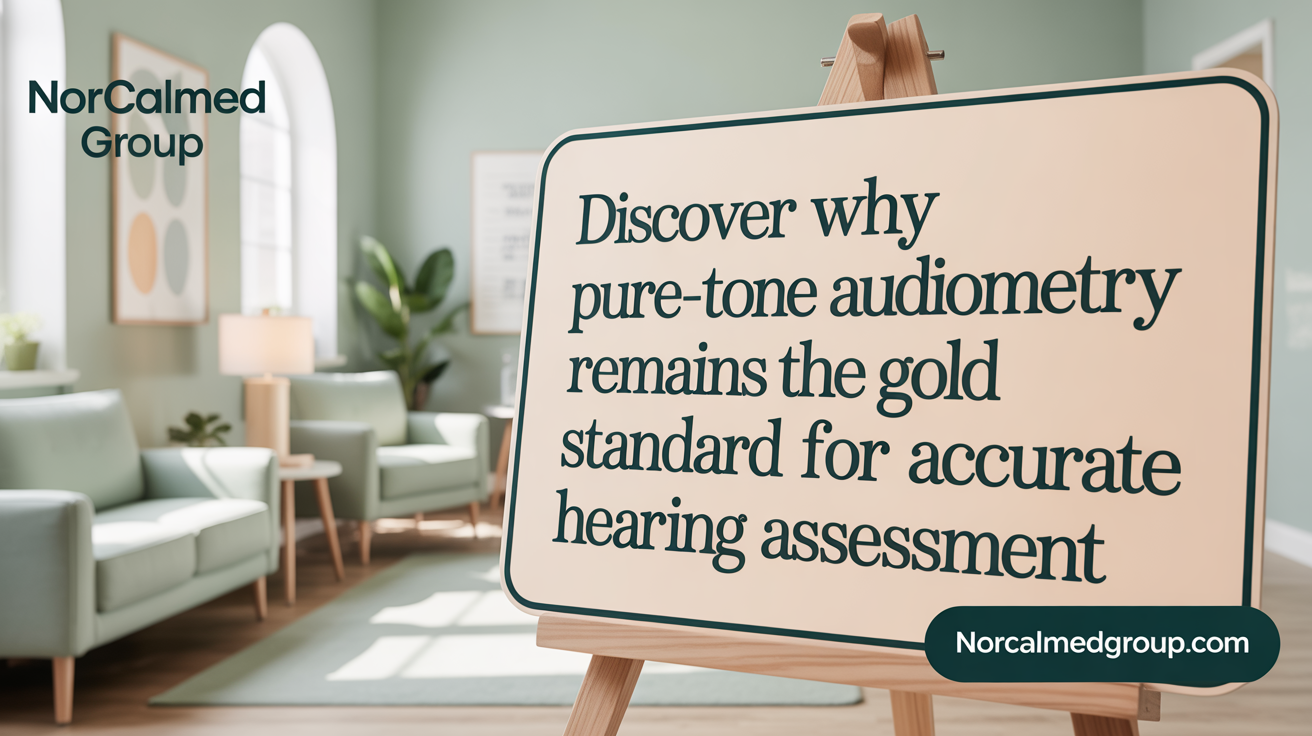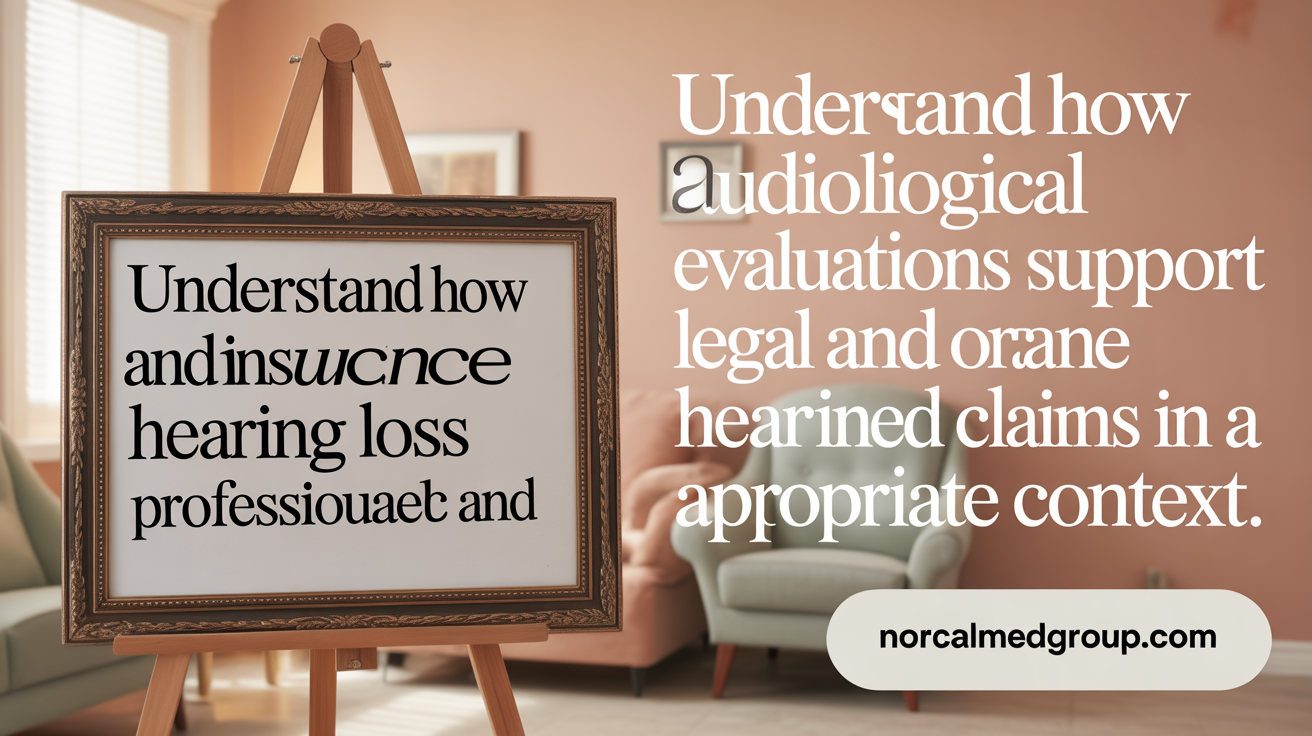Understanding Audiological Testing in Hearing Loss Claims
Hearing loss affects millions worldwide, significantly impacting daily communication and quality of life. When it comes to insurance, legal, or disability claims related to hearing impairment, establishing accurate and credible evidence is essential. Audiological tests provide an objective, standardized method to assess hearing function, aiding claimants and evaluators alike. This article explores how these tests support hearing loss claims by detailing common evaluation methods, explaining how degrees and types of hearing loss are determined, and examining their significance in various claims contexts, including veterans' benefits and workers' compensation.
Comprehensive Overview of Audiological Evaluation Methods

What are the main types of audiological tests used for assessing hearing loss?
Assessing hearing loss involves various specialized tests that help determine the nature, severity, and possible causes of auditory problems. Each test provides unique insights, guiding appropriate treatment options.
Pure-tone audiometry is a foundational test that measures the faintest sounds a person can hear across a range of frequencies. During this procedure, conducted in a soundproof booth, patients wear headphones and press a button whenever they hear a tone. The results, plotted on an audiogram, show the quietest sounds detectable at different pitches and loudness levels, helping to identify whether hearing loss is mild, moderate, or severe.
Speech audiometry complements pure-tone testing by assessing how well a person can understand spoken language. This involves tests like speech reception threshold (SRT) and word recognition score (WRS), which measure speech detection and comprehension at various sound levels. Speech audiometry helps evaluate the functional impact of hearing loss on communication, which is critical for diagnosis and treatment.
Tympanometry examines middle ear function by measuring eardrum movement in response to air pressure changes. It helps identify issues such as fluid buildup, eardrum perforations, or ossicular chain problems. This test is especially useful in diagnosing conductive hearing loss, which results from problems in the outer or middle ear.
Otoacoustic emissions (OAEs) test cochlear function by detecting sounds generated by the inner ear. A small probe is placed in the ear canal, and sounds produced by the cochlea in response to clicks or tones are measured. OAEs are particularly valuable for screening newborns and young children because they are quick, non-invasive, and do not require patient response.
Auditory brainstem response (ABR) testing evaluates the neural pathways from the cochlea through the brainstem. Electrodes are placed on the scalp, and sounds are played into the ears. The test measures electrical responses generated by the auditory nerve and brainstem, assisting in diagnosing neural or retrocochlear issues, and is useful for infants or uncooperative patients.
| Test Type | Purpose | Method | Typical Use | Additional Notes |
|---|---|---|---|---|
| Pure-tone audiometry | Measures hearing thresholds | Threshold search via headphones | Determine degree of hearing loss | Standard; basic for initial assessment |
| Speech audiometry | Assess speech understanding | Speech recognition tests | Evaluate communication impact | Supports hearing aid fitting |
| Tympanometry | Assess middle ear function | Air pressure and eardrum movement measurement | Detect fluid, perforations | Conducted with a tympanometer |
| Otoacoustic emissions | Test cochlear function | Sound stimuli and response measurement | Newborn and pediatric screening | Non-invasive, quick |
| ABR | Evaluate neural pathways | Electrical responses to sounds | Assess neural integrity | Used in infants and for neurological diagnostics |
Understanding these tests helps healthcare providers accurately diagnose hearing issues, tailor appropriate interventions, and provide essential evidence for hearing loss claims and legal proceedings. Proper assessment is crucial in supporting effective treatment and improving communication ability for individuals with hearing impairments.
Pure-Tone Audiometry: The Gold Standard for Hearing Assessment

What is pure-tone audiometry and why is it considered accurate for assessing hearing loss?
Pure-tone audiometry is a widely used, standardized hearing test performed by trained audiologists. During the test, individuals listen to a series of pure tones at different pitches and loudness levels through headphones in a soundproof environment. The goal is to identify the quietest sounds they can hear at each frequency, which are then plotted on an audiogram. This graph visually represents hearing sensitivity across various pitches, helping clinicians determine the type and severity of hearing loss.
The accuracy of pure-tone audiometry lies in its ability to provide objective, quantifiable measurements of auditory thresholds. Because the test is conducted in controlled conditions with calibrated equipment, it reliably captures an individual’s true hearing ability. This precision makes it the gold standard for diagnosing hearing impairments and guiding treatment plans.
Recent research underscores the reliability of innovative tools like smartphone-based hearing tests. These app-based assessments have demonstrated a high correlation with traditional audiometry results, especially at higher frequencies and speech ranges. Studies show that such portable tests can achieve sensitivity and specificity comparable to clinical procedures, making them valuable, particularly in remote or resource-limited settings.
In summary, pure-tone audiometry’s proven accuracy, combined with the validation of smartphone applications, affirms its essential role in hearing health care. Its precise assessments enable tailored interventions, ensuring patients receive the most appropriate treatment for their hearing loss.
Determining the Degree and Type of Hearing Loss
How is the degree and type of hearing loss determined during an audiological evaluation?
The primary tool used to assess the severity and nature of hearing loss is pure-tone audiometry. This test measures the softest sounds a person can hear at various pitches or frequencies, typically displayed graphically on an audiogram.
In an audiogram, thresholds for hearing are plotted across different frequencies, usually from low to high pitches. The results show the quietest level of sound a person can detect, helping to identify whether hearing loss is mild, moderate, severe, or profound.
Hearing loss classification by decibels (dB HL) is as follows:
| Decibel Range | Description | Impact |
|---|---|---|
| -10 to 15 dB | Normal hearing | Slight or no hearing impairment |
| 16 to 40 dB | Mild hearing loss | Difficulty hearing soft sounds, especially in noisy environments |
| 41 to 55 dB | Moderate hearing loss | Challenges understanding speech at normal volumes |
| 56 to 70 dB | Moderately severe loss | Significant difficulties with speech comprehension |
| 71 to 90 dB | Severe hearing loss | Need for powerful amplification or other interventions |
| 91+ dB | Profound hearing loss | Little or no hearing without assistive devices |
Conductive vs sensorineural hearing loss
The distinction between conductive and sensorineural hearing loss is crucial. During audiometric testing, both air and bone conduction thresholds are measured.
-
Conductive hearing loss occurs when sound cannot efficiently pass through the outer or middle ear. It is suggested by an air-bone gap greater than 15 dB HL, meaning air conduction thresholds are worse than bone conduction thresholds.
-
Sensorineural hearing loss involves damage to the inner ear or auditory nerve. Here, air and bone conduction thresholds are closely matched, but both are elevated above normal levels.
-
Mixed hearing loss presents as both a conductive component (air-bone gap) and sensorineural damage (elevated thresholds in both air and bone testing).
Additional tests such as tympanometry and speech understanding tests provide further insights into the nature of the hearing impairment.
Use of additional tests
Other assessments complement pure-tone audiometry:
- Speech audiometry evaluates how well a person understands spoken words.
- Tympanometry examines middle ear function.
- Otoacoustic emissions (OAEs) check outer hair cell function of the cochlea.
- Auditory brainstem responses (ABR) assess nerve and brainstem pathways.
Together, these tests help audiologists accurately diagnose the type of hearing loss and recommend appropriate treatment options. Precise identification supports effective management and is often critical in legal or insurance claims related to hearing impairment.
General Levels and Classification of Hearing Loss Severity

What are the general levels or degrees of hearing loss used in audiological assessments?
Hearing loss assessment relies on measuring the softest sounds a person can hear across various pitches, represented on an audiogram. These measurements are expressed in decibels hearing level (dB HL). Based on the audiometric thresholds, hearing loss is classified into several categories.
Normal hearing typically ranges from -10 to 25 dB HL. Mild hearing loss is characterized by thresholds between 26 and 40 dB HL, often affecting the ability to hear soft sounds or speech in noisy environments. Moderate loss spans from 41 to 55 dB HL, where understanding speech becomes more challenging. Severe loss covers 56 to 70 dB HL, making most speech sounds difficult to perceive without amplification. Profound hearing loss is defined by thresholds exceeding 70 dB HL, with some classifications setting it at 91+ dB HL, indicating most sounds are inaudible without assistive devices.
The classification system may vary slightly depending on standards used, such as those from the World Health Organization (WHO). These levels help audiologists diagnose the severity of hearing impairment and determine appropriate treatment. For example, mild to moderate losses might be managed with hearing aids, while profound losses may require cochlear implants.
Understanding these thresholds is essential not only for clinical treatment but also for legal and insurance claims, as evidence of the degree of hearing loss influences compensation and rehabilitation options.
| Classification | dB HL Range | Description | Implication |
|---|---|---|---|
| Normal | -10 to 25 | No impairment | No treatment required |
| Mild | 26 to 40 | Slight difficulty hearing | Possible hearing aid consideration |
| Moderate | 41 to 55 | Significant difficulty understanding speech | Hearing aids often helpful |
| Severe | 56 to 70 | Difficult to hear most speech sounds | Amplification usually necessary |
| Profound | 71+ | Very limited hearing, most sounds inaudible | Cochlear implants may be needed |
This classification assists audiologists in evaluating the impact of hearing loss on daily communication and guides treatment decisions.
Step-by-Step Process of Audiological Testing for Hearing Loss Claims
What is the process involved in audiological testing for substantiating hearing loss claims?
The journey to accurately diagnose and support hearing loss claims begins with a detailed initial evaluation by a qualified audiologist. This process typically starts with taking a thorough medical history and gathering information about the patient's hearing difficulties, work environment, and potential noise exposure, especially in cases related to military service or occupational hazards.
Next, the audiologist performs an otoscopic examination of the outer ear and ear canal to check for blockages such as earwax or signs of infection that could explain conductive hearing loss. Once the physical check confirms no immediate issues, the core of the assessment involves various hearing tests.
The primary assessment method is pure-tone audiometry, where the patient sits in a soundproof booth and wears headphones. The audiologist plays specific tones at different frequencies and volume levels, recording the softest sounds the patient can hear across a range of pitches, from 250 Hz to 8,000 Hz. These thresholds are charted on an audiogram, visually representing hearing sensitivity.
In addition to air conduction testing, bone conduction testing may be performed to differentiate between conductive and sensorineural hearing loss. Speech recognition tests, such as speech audiometry, are also conducted to evaluate understanding of spoken language at various loudness levels. Tests like speech-in-noise assess functional hearing in real-world environments.
Further assessments include tympanometry to evaluate middle ear function and acoustic reflex testing to measure involuntary muscle responses within the ear. If indicated, supplementary tests such as otoacoustic emissions (OAEs) are performed to assess outer hair cell function, and vestibular evoked myogenic potentials (VEMP) may be taken to evaluate the auditory nerve pathways.
All test results are compiled into detailed reports, with audiograms serving as a critical visual tool for analyzing hearing thresholds. These reports help clinicians determine the severity—ranging from mild to profound—and type—conductive, sensorineural, or mixed—of hearing loss.
The complete audiological assessment generally takes about 30 minutes to an hour. The results are reviewed with the patient immediately, discussing possible causes, treatment options like hearing aids or surgery, and implications for disability claims.
This comprehensive testing approach ensures sufficient evidence to substantiate hearing loss claims, guide treatment, and provide important support documentation for insurance, legal, or disability evaluation purposes.
Audiological Tests in Insurance, Legal, and Workers’ Compensation Claims

How do audiological tests support hearing loss claims in insurance or legal contexts?
Audiological assessments play a pivotal role in objectively verifying hearing loss claims, especially within insurance, legal, and workers’ compensation cases. These tests generate precise and measurable data about a person's auditory function, which is essential for establishing the legitimacy of a claim.
Key procedures include pure-tone audiometry, speech recognition testing, tympanometry, otoacoustic emissions (OAE), and auditory evoked potentials. These tests help determine the type of hearing loss—whether conductive, sensorineural, or mixed—as well as its severity and impact on daily communication.
Conducted by qualified audiologists in soundproof booths under standardized conditions, these assessments are designed to produce reliable results. They help differentiate genuine impairment from exaggerated or nonorganic hearing loss by identifying inconsistencies or discrepancies in the test results.
The audiometric data obtained can be used to support the claimant’s statement of disability by providing evidence of actual hearing impairment comparable to the reported difficulties. This evidence is critical for insurance companies to evaluate damages and for legal entities when adjudicating claims.
Furthermore, audiological records are often integral to establishing work-related hearing loss or damage caused by specific incidents, such as exposure to loud noise in the workplace. Overall, these tests serve as a scientific backbone supporting fair, accurate, and evidence-based decision-making in hearing loss claims.
| Test Type | Purpose | Use in Claims | Features |
|---|---|---|---|
| Pure-tone audiometry | Measures softest sounds across pitches | Determines severity & type of hearing loss | Involves wearing headphones; quick to perform |
| Speech recognition tests | Assesses understanding of spoken words | Evaluates functional hearing ability | Includes word recognition and speech in noise tests |
| Tympanometry | Examines middle ear function | Detects fluid or eardrum issues | Uses air pressure in ear canal |
| Otoacoustic Emissions | Measures cochlear (inner ear) function | Supports diagnosis of sensorineural loss | Involves small probe in ear canal |
| Auditory Brainstem Response | Checks neural pathways | Confirms diagnosis, especially in non-cooperative patients | Uses electrodes and sound stimuli |
Effective use of detailed audiometric data aids insurers and courts in making informed decisions regarding disability ratings, compensation levels, and legal judgments. In this context, audiological testing remains an indispensable element of the hearing loss evaluation process.
Special Considerations for Veterans’ Hearing Loss and Tinnitus Claims

VA hearing loss claim process
For veterans seeking disability compensation for hearing loss or tinnitus, a thorough audiological assessment is essential. The process begins with a medical review and audiometric testing, often conducted by VA-accredited audiologists or healthcare providers. These tests help determine the type, severity, and impact of hearing issues, forming the core evidence needed for the claim.
It’s important to have detailed documentation of military noise exposure, such as service records, noise charts related to military occupational specialties, and buddy statements. This evidence supports a connection between service and the diagnosed hearing condition.
C&P exams and audiometric assessments
The VA typically requires a Compensation and Pension (C&P) exam to evaluate hearing loss. During this exam, audiometric tests including pure tone audiometry are performed to chart hearing thresholds and confirm the diagnosis. The audiologist also conducts physical ear examinations and may include additional tests like speech recognition, tympanometry, or otoacoustic emissions.
Results from audiometry provide an objective basis for assigning a disability rating, which ranges from 0% to 100%. Higher ratings depend on the severity of hearing loss, often measured in decibels of hearing threshold loss.
importance of military noise exposure documentation
Documenting noise exposure during military service is crucial. It can include official records of noisy environments, MOS noise exposure charts, and sworn statements from fellow service members. This evidence helps establish a service connection, especially when audiometric results show hearing deficits consistent with noise-induced hearing loss.
Supporting documents, combined with audiological test results, strengthen the claim and can influence the compensation awarded. Prompt and comprehensive documentation ensures a clearer and more compelling case.
| Aspect | Important Details | Additional Notes |
|---|---|---|
| Audiological Tests | Pure tone audiometry, speech recognition | Used to determine type and severity of loss |
| Evidence Needed | Service records, noise exposure charts, buddy statements | Supports link between service and hearing loss |
| VA Ratings | 0% to 100%, based on audiogram results | Guides compensation and treatment |
| Common Tests | Tympanometry, otoacoustic emissions, speech testing | Clarify the nature of hearing impairment |
| Claim Support | Clear documentation, detailed audiograms, physical exams | Validates the connection and severity |
Understanding the proper documentation and assessment procedures is vital for veterans pursuing their claims. Accurate audiological evaluations and thorough military noise exposure records can significantly impact the success and extent of their benefits.
Billing, Coding, and Procedural Guidelines for Audiology Services in Claims
CPT and ICD coding for audiology tests
Proper coding is essential for accurate billing and claim processing. Common CPT codes include 92557 for comprehensive hearing tests, 92567 for hearing aid evaluation, and 92588 for comprehensive OAE testing. ICD codes classify the diagnosis, with codes like H90.3 for sensorineural hearing loss. Using current procedural terminology (CPT) codes alongside relevant ICD codes ensures appropriate documentation.
Billing principles
Billing must reflect the actual services performed. For unilateral tests, modifiers like -52 might be used if testing is reduced. It is vital to document the reason for testing, the specific procedures, and whether tests were full or limited. When billing for procedures such as speech-in-noise testing or VEMP, select the code that best describes the service, and include modifiers if services are partial or altered.
Documentation requirements
Accurate and comprehensive documentation underpins successful claims. Reports should include audiometric data, calibration reports, physical exam findings, and detailed test results such as audiograms. For Medicare and other insurers, adherence to standards like ANSI ambient noise limits during testing is mandatory. Including a physician’s order or referral can strengthen the claim, especially if normal results are involved. Clear documentation of calibration status and equipment details is also required.
Additional considerations
Ensure that audiological assessments meet all regulatory standards, and proper coding matches the performed procedure. For example, hearing aid evaluations must specify fitting and adjustments, often billed with 92626 or 92627. Using appropriate modifiers and detailed reports supports reimbursement and legal documentation, particularly in hearing loss claims. Staying updated on guideline changes, such as CPT updates or ICD revisions, helps streamline claims and prevent delays.
| Aspect | Description | Notes |
|---|---|---|
| CPT Codes | 92557, 92567, 92588, 92626, 92627 | Reflect specific services and evaluations |
| ICD Codes | H90.3, H90.0, H91.2 | Indicate diagnostic findings |
| Modifiers | -52, -22 | Denote partial services or increased complexity |
| Documentation | Audiogram, calibration, physical exam, referral | Supports billing and claims |
Audiological Testing’s Contribution to Research and Hearing Health Management
VA research initiatives
The U.S. Department of Veterans Affairs (VA) conducts extensive research focused on hearing disorders, aiming to improve diagnosis, treatment, and management of hearing loss and tinnitus in Veterans. VA research has been instrumental in understanding how early detection and various treatment methods can enhance quality of life. Notably, VA studies have validated the effectiveness of devices such as hearing aids and cochlear implants, supporting their use for Veterans with moderate to severe sensorineural loss. The National Center for Rehabilitative Auditory Research (NCRAR), established in 1997, continues to foster innovative research to develop better interventions.
Hearing aids and cochlear implants usage
Hearing aids and cochlear implants are frequently pivotal in managing hearing impairments. Modern hearing aids are highly customizable, fitting different degrees and types of hearing loss, especially in the inner ear. Cochlear implants are offered for cases where hearing aids provide insufficient benefit, directly stimulating the auditory nerve through sophisticated electrodes. In the VA system, both devices are vital in restoring hearing function, improving communication, and supporting claims for disability compensation.
Progressive tinnitus management
VA has adopted an interdisciplinary approach with its Progressive Tinnitus Management (PTM) program. PTM assists Veterans in coping with tinnitus, a prevalent service-connected disability. The program involves a team of clinicians offering education, counseling, and sound therapies, often delivered remotely via telephone. Its evidence-based protocols help reduce the disturbance caused by tinnitus, thereby improving overall mental health and daily functioning.
Impact on treatment and claims
Audiological assessments are essential in diagnosing the severity and type of hearing loss, which directly influence the treatment plan. Accurate audiometric testing provides objective evidence needed for disability claims and compensation, supporting the connection between service-related noise exposure and hearing impairment. Comprehensive evaluation results, including audiograms and speech audiometry, help justify the level of disability rated from 0% to 100%, affecting VA benefit decisions. Overall, ongoing audiological research enhances treatment options, ensuring Veterans receive tailored care and substantiated claims support.
The Indispensable Role of Audiological Testing in Hearing Loss Claims
Audiological assessments are a cornerstone in substantiating hearing loss claims, providing objective, reliable, and detailed information about an individual's auditory function. From the gold standard pure-tone audiometry to specialized tests for middle ear function and neural pathways, these evaluations enable precise diagnosis and characterization of hearing loss. They are critical in insurance, legal, disability, and veteran claims, ensuring fair adjudication through scientific rigor. Additionally, proper billing and coding practices support the integrity of audiology services within claims. Ongoing research and clinical advancements, particularly in veteran populations, continue to improve hearing health management. Ultimately, audiological testing not only supports claims but also guides effective treatment and rehabilitation, enhancing the quality of life for those affected by hearing loss.
References
- Hearing loss - Diagnosis and treatment - Mayo Clinic
- Speech Audiometry - StatPearls - NCBI Bookshelf
- Audiometry Screening and Interpretation - AAFP
- Degree of Hearing Loss - ASHA
- Nonorganic Functional Hearing Loss - StatPearls - NCBI Bookshelf
- What happens in an audiology appointment - RNID
- Hearing tests | Better Health Channel
- Billing and Coding for Audiology Services FAQs - ASHA
- What You Need to Know About An Audiological Assessment
- Audiology Services - CMS
